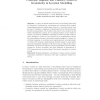221 search results - page 29 / 45 » Relation Algebras and their Application in Temporal and Spat... |
KI
2010
Springer
13 years 6 months ago
2010
Springer
Location models are data structures or knowledge bases used in Ubiquitous Computing for representing and reasoning about spatial relationships between so-called smart objects, i.e....
SC
1995
ACM
13 years 11 months ago
1995
ACM
Rapid increases in computing and communication performance are exacerbating the long-standing problem of performance-limited input/output. Indeed, for many otherwise scalable para...
PSSS
2003
13 years 8 months ago
2003
: RDF-based tools promise to provide a base for reasoning about metadata and about situated data—data describing entities situated in time and space—that is superior to alterna...
SEMWEB
2010
Springer
13 years 5 months ago
2010
Springer
RDF(S) and OWL 2 currently support only static ontologies. In practice, however, the truth of statements often changes with time, and Semantic Web applications often need to repres...
KDD
2005
ACM
14 years 8 months ago
2005
ACM
In this paper, we present a general framework to discover spatial associations and spatio-temporal episodes for scientific datasets. In contrast to previous work in this area, fea...

